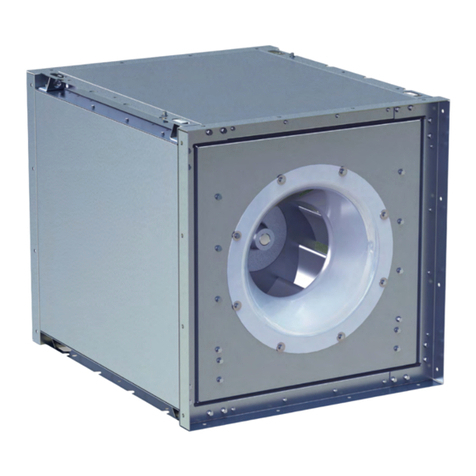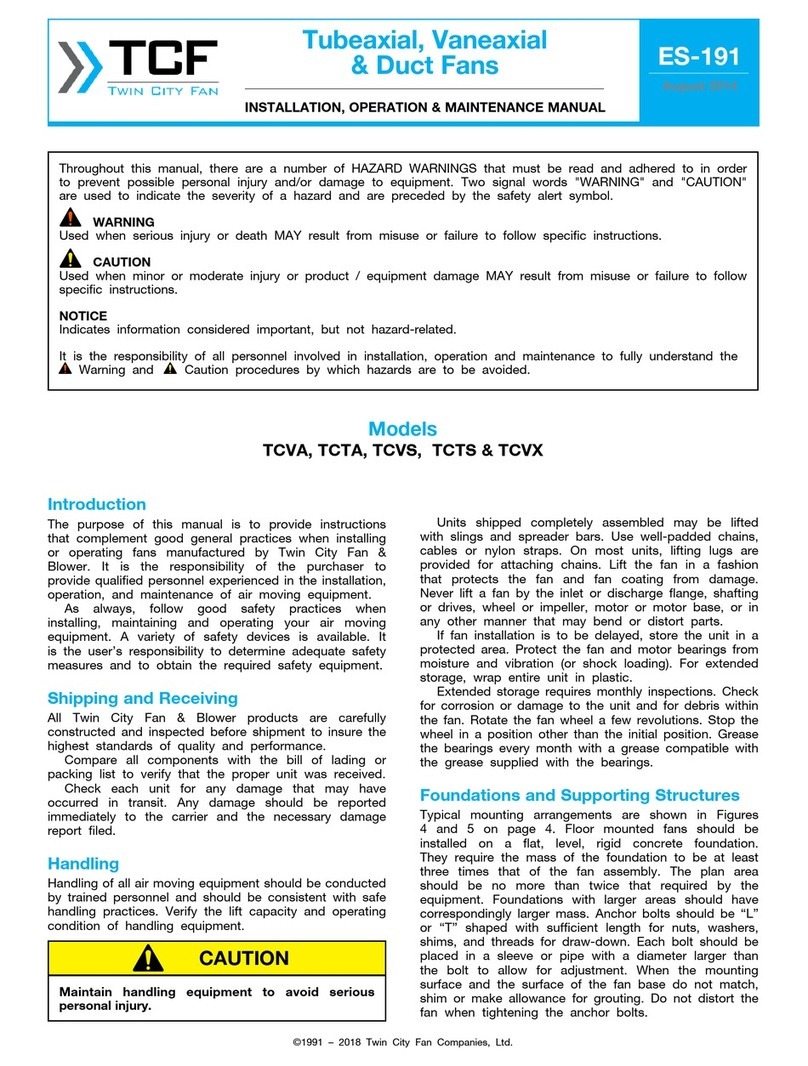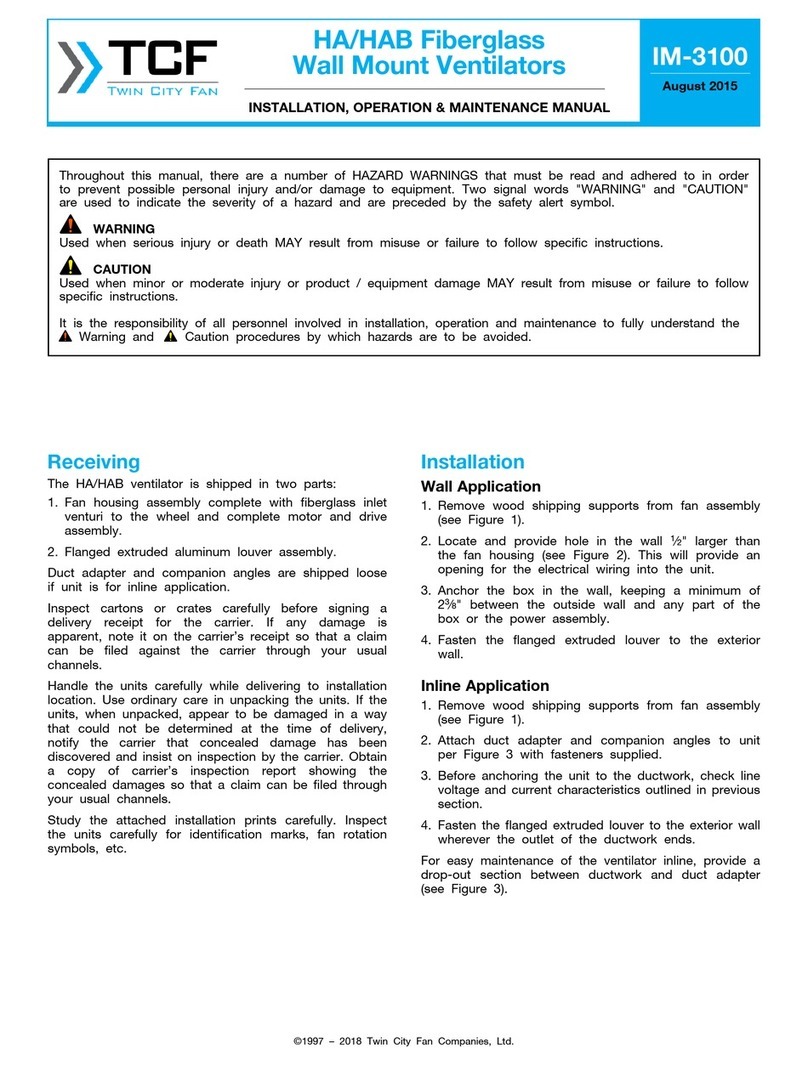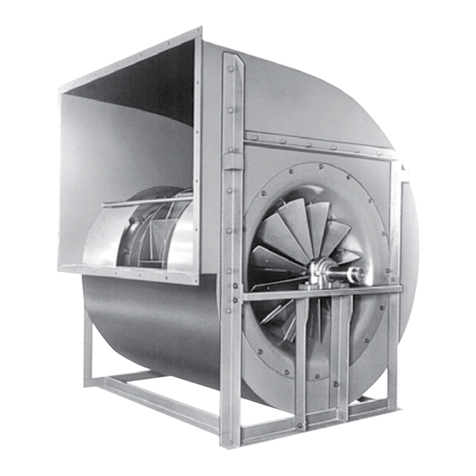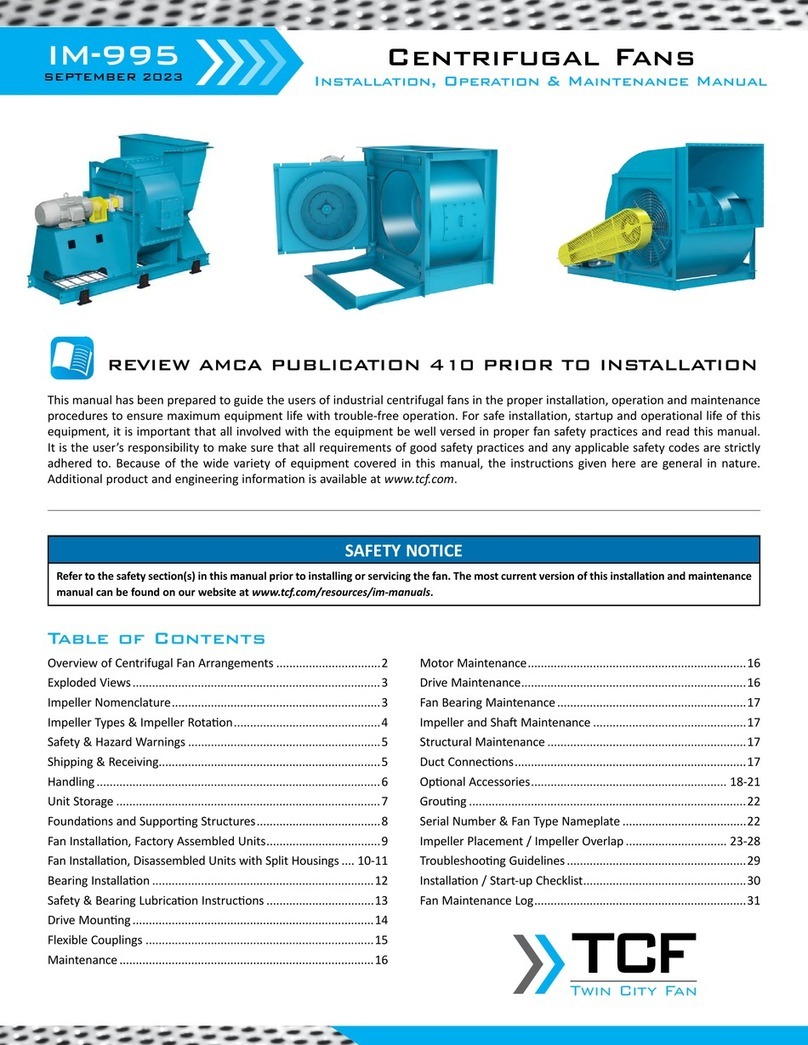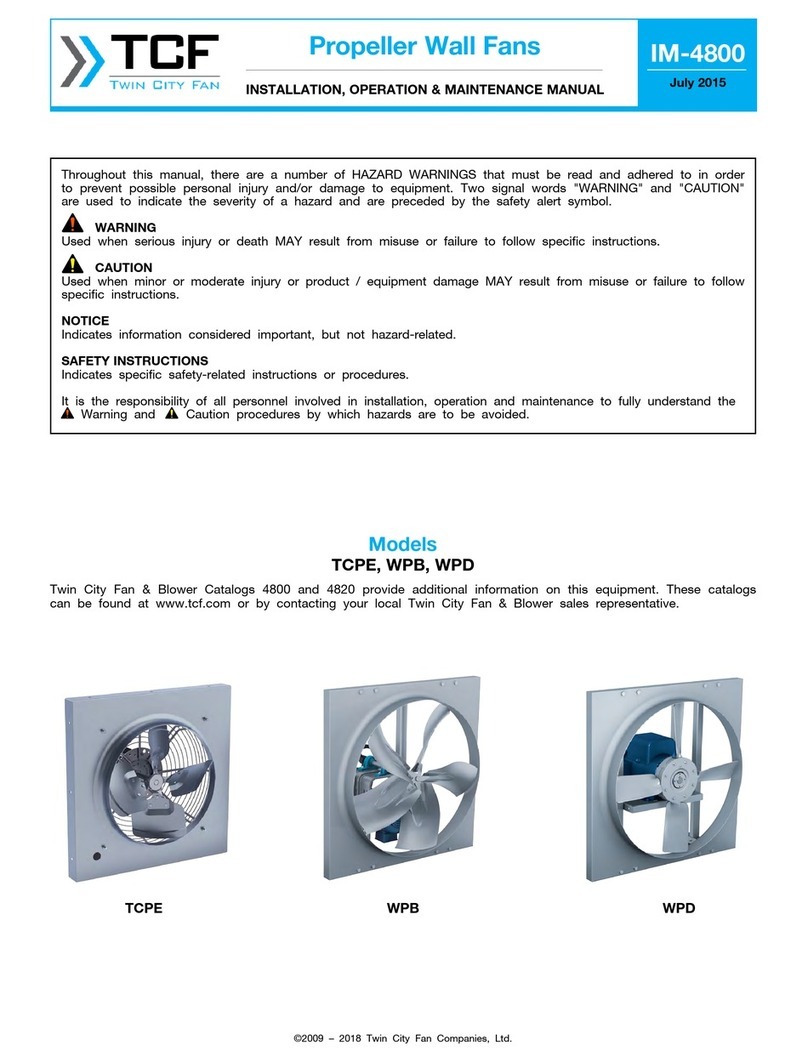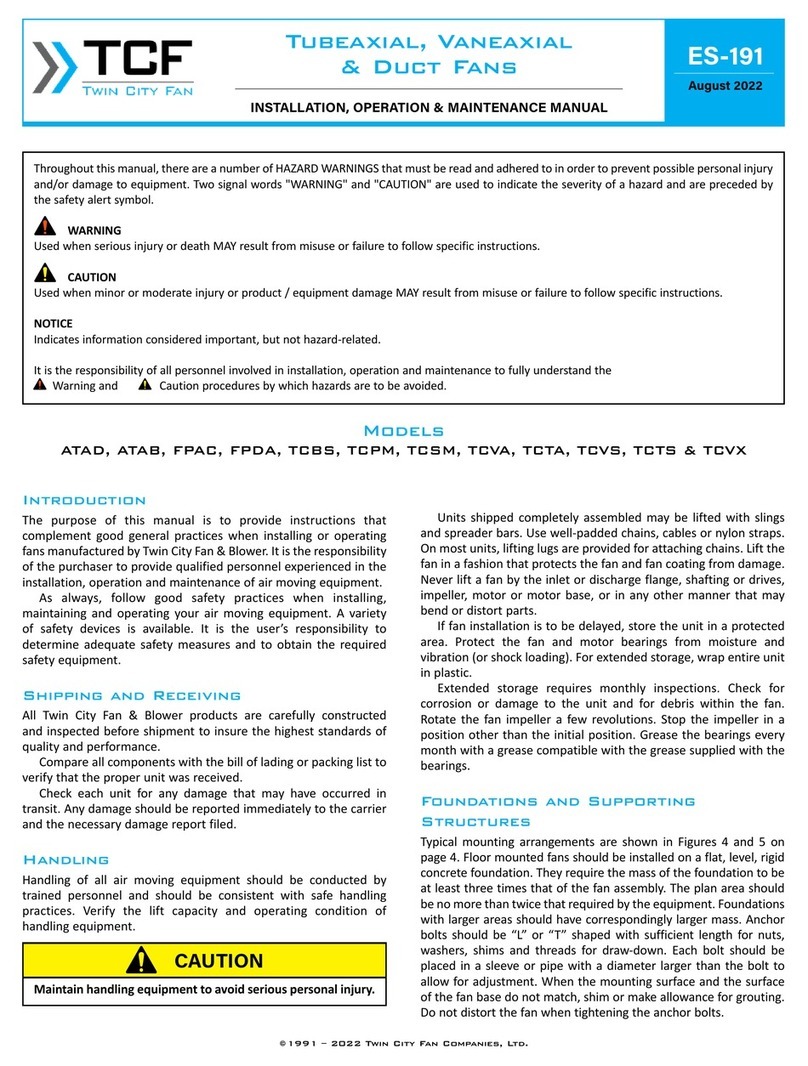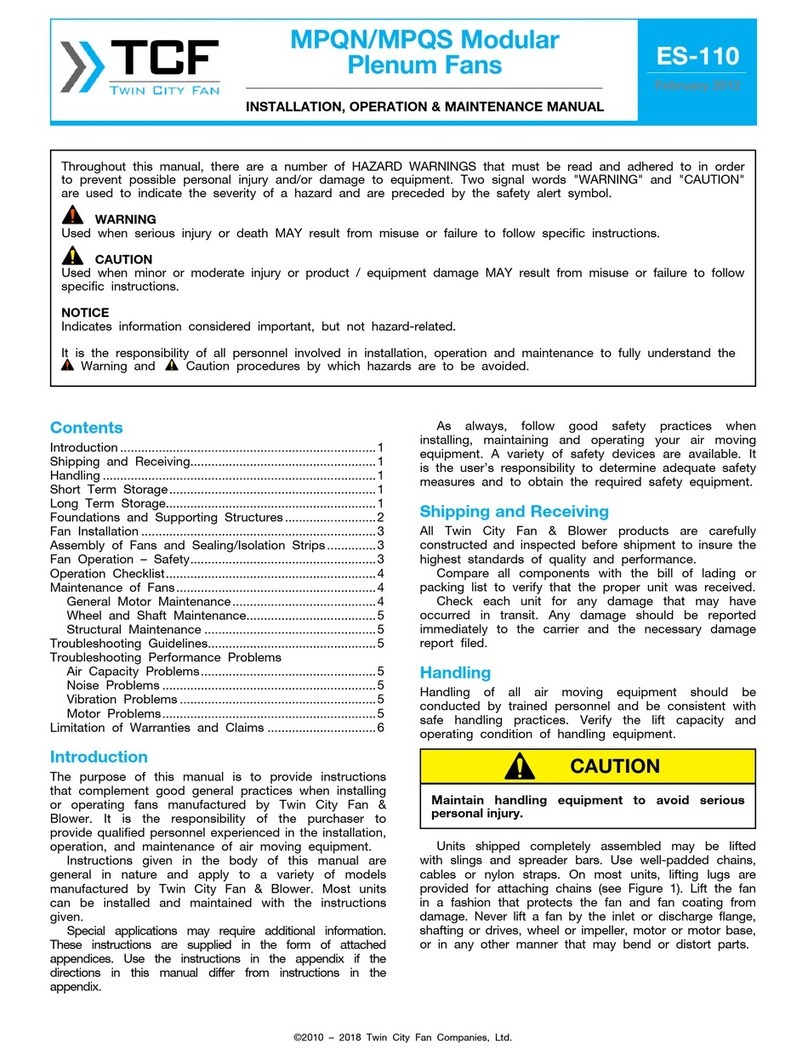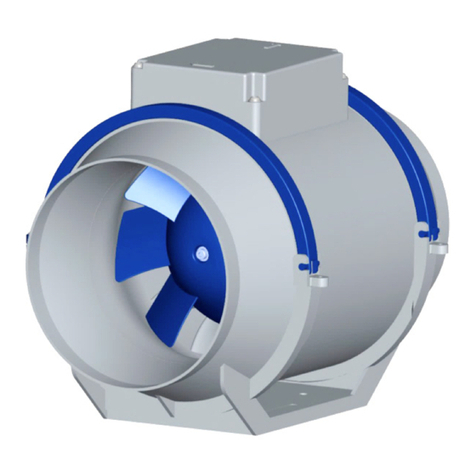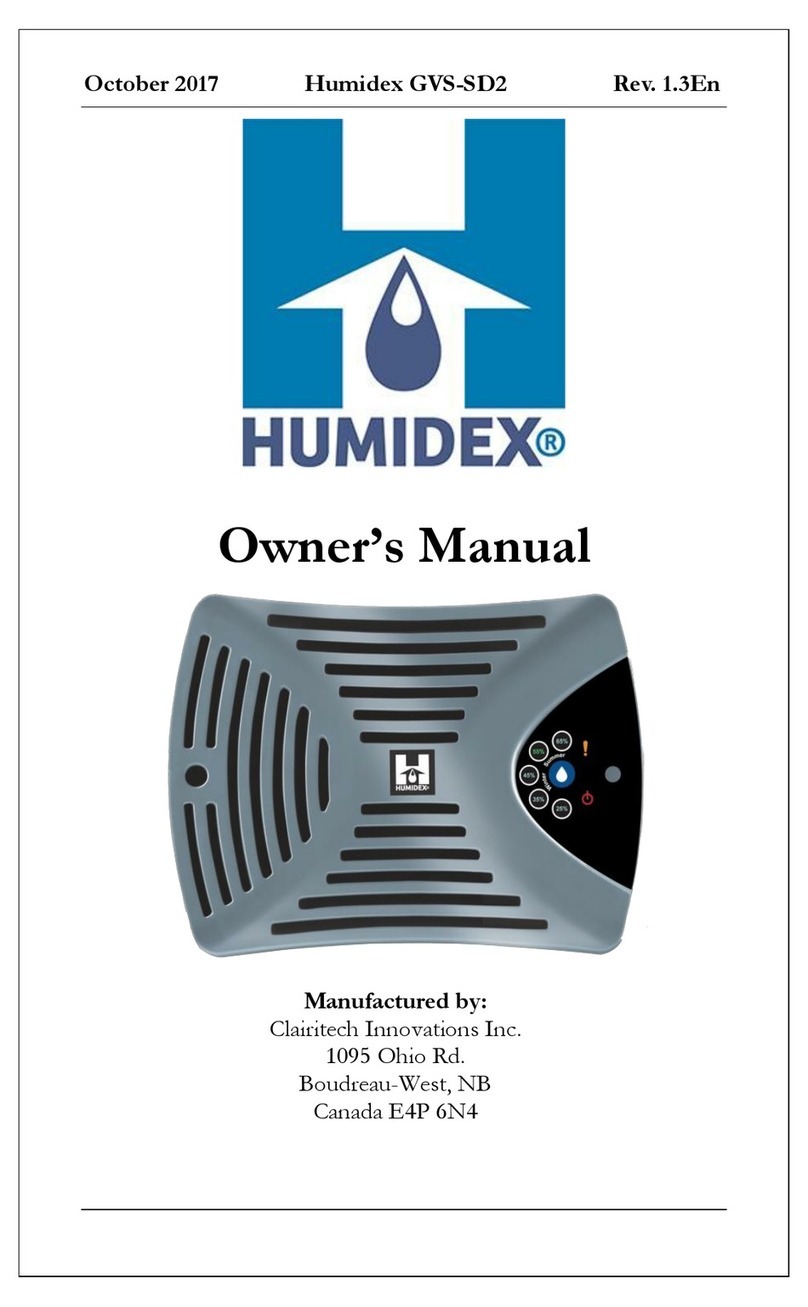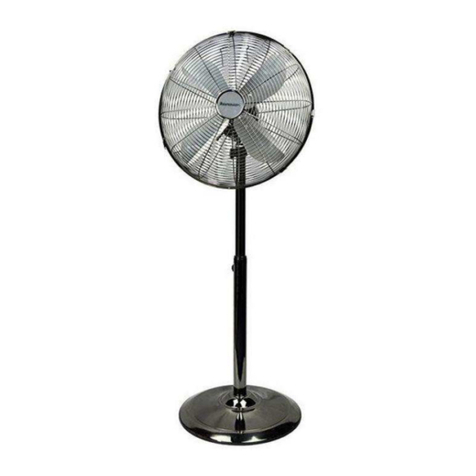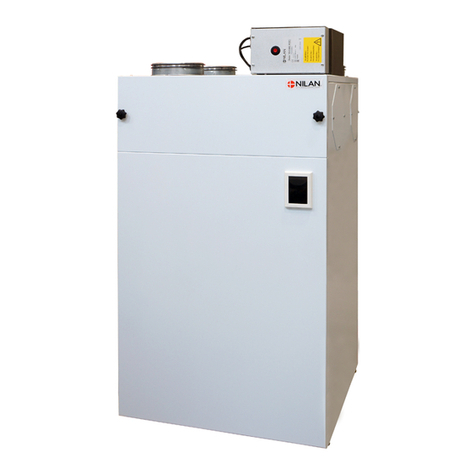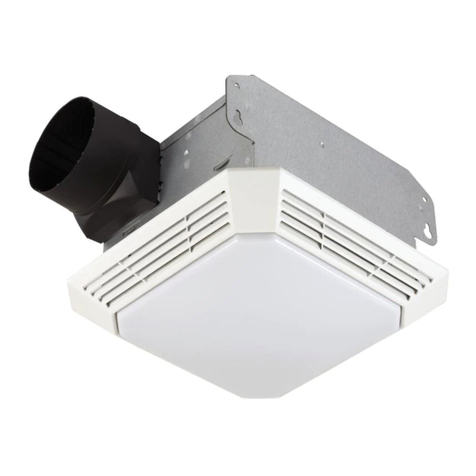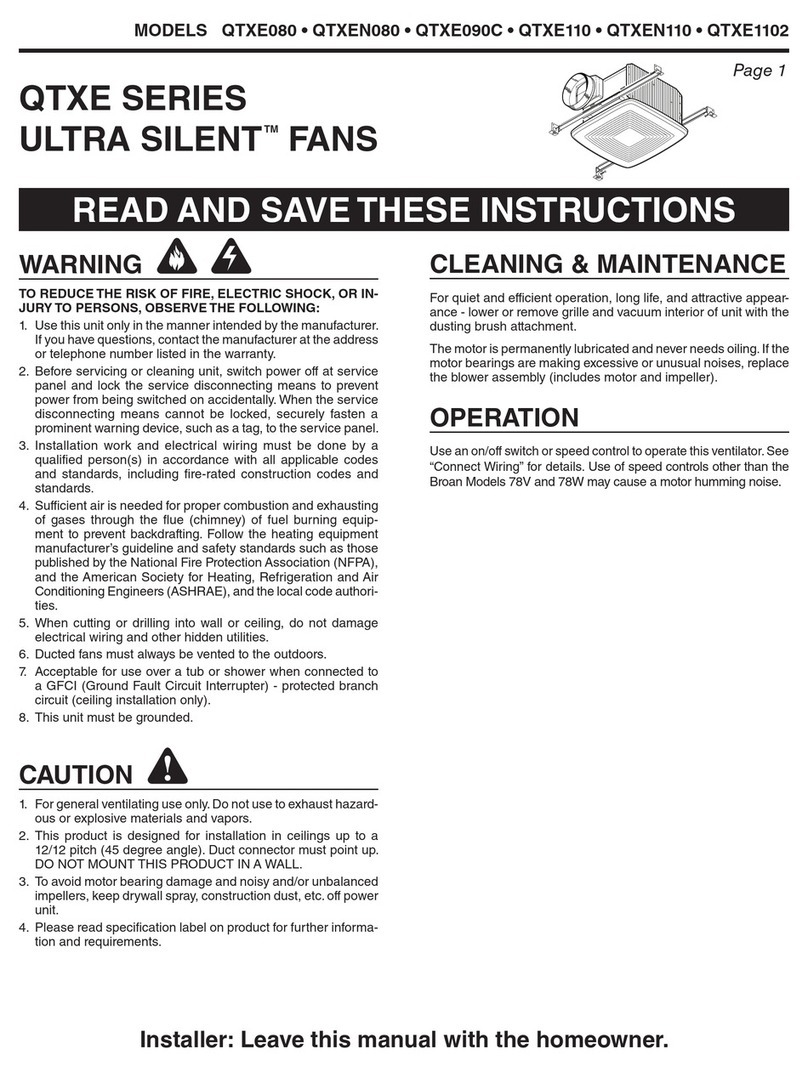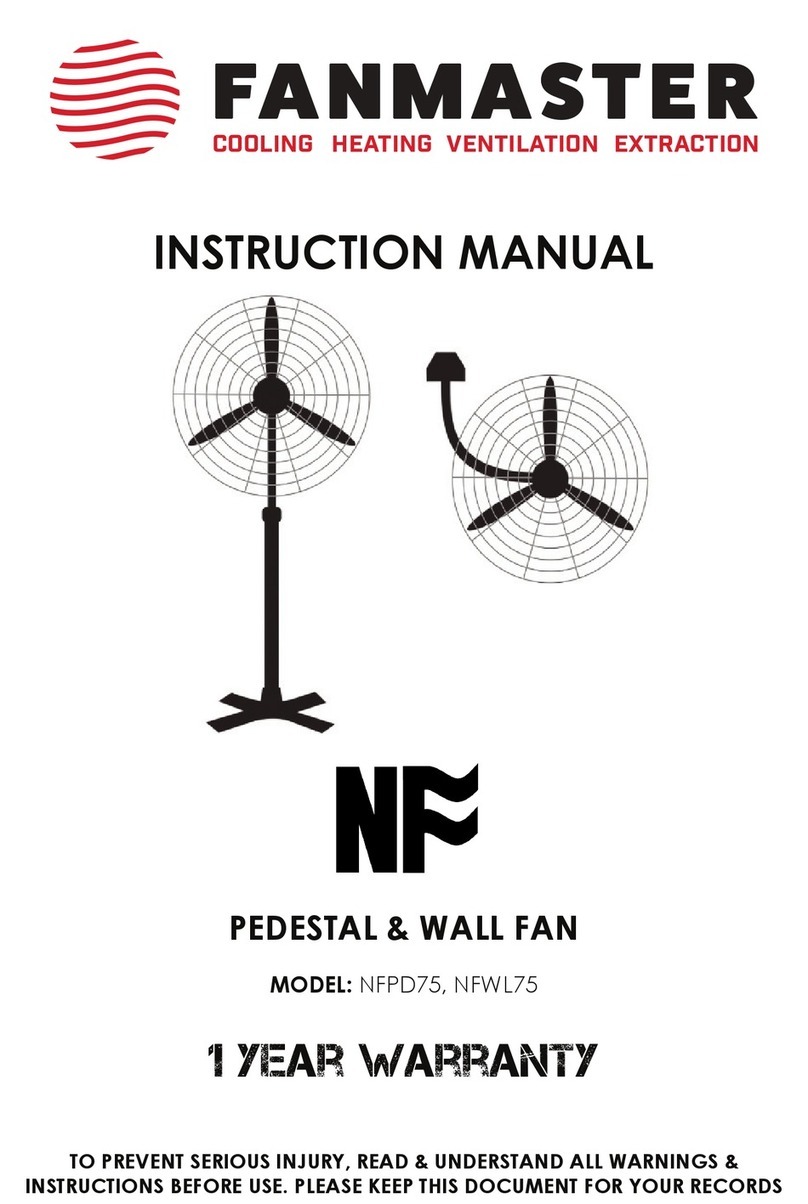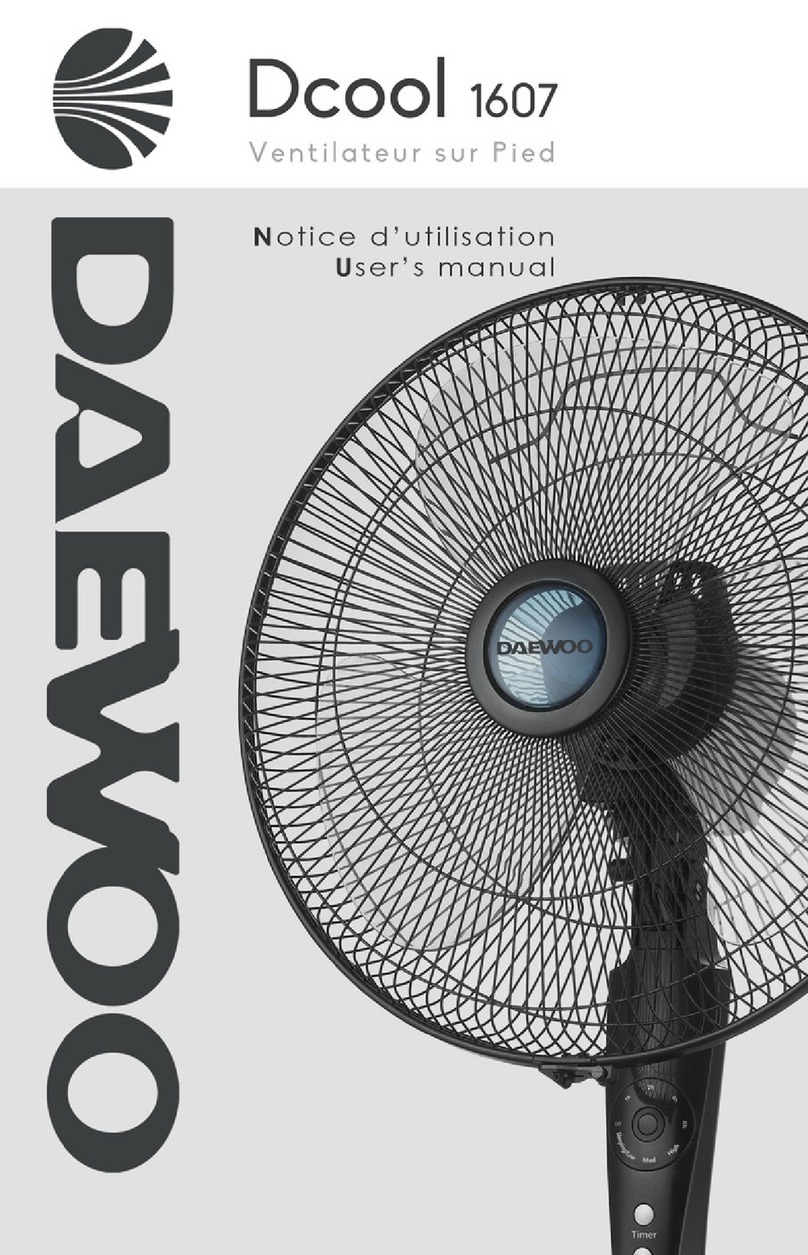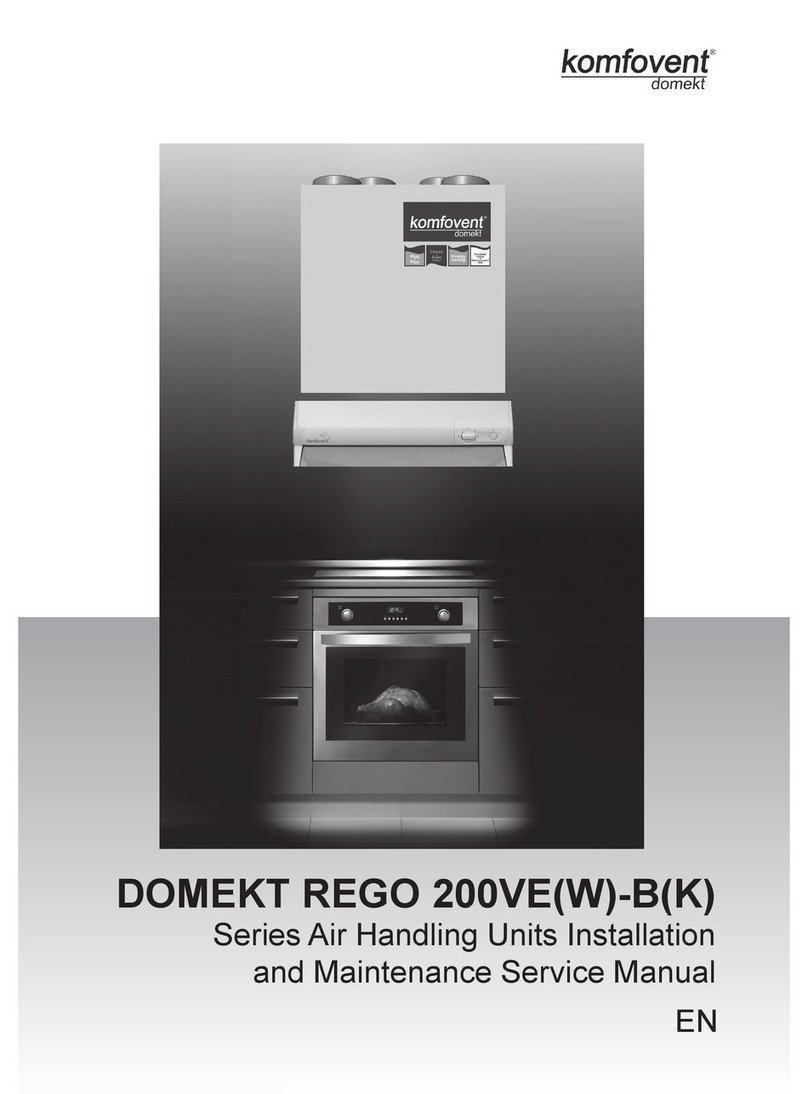TCF TSL Instruction manual

Introduction
This bulletin has been prepared to guide the users of
TSL Inline Centrifugal Fans and QSL Mixed Flow Fans
in the proper installation, operation and maintenance
procedures to insure maximum equipment life with
trouble-free operation.
Shipping and Receiving
All Twin City Fan & Blower products are carefully
constructed and inspected before shipment to insure
the highest standards of quality and performance.
Compare all components with the bill of lading or
packing list to verify that the proper unit was received.
Check each unit for any damage that may have
occurred in transit. Any damage should be reported
immediately to the carrier and the necessary damage
report filed.
Handling
Handling of all air moving equipment should be
conducted by trained personnel and be consistent with
safe handling practices. Verify the lift capacity and
operating condition of handling equipment.
Units shipped completely assembled may be lifted
with slings and spreader bars. Use well-padded chains,
cables or nylon straps (see Figure 1). On most units,
lifting lugs are fashioned to protect the fan and fan
housing from damage. Never lift a fan by the inlet or
discharge flange, shafting or drives, wheel, motor or
motor base, or in any other manner that may bend or
distort parts.
If installation is to be delayed, store the unit in a
protected area. Protect the fan and motor bearings from
moisture and vibration (or shock loading). For extended
storage, wrap entire unit in plastic. Wrap loosely so air
may circulate around the fan and moisture does not
collect, or use a desiccant. Extended storage requires
monthly inspections. Check for corrosion or damage to
the unit and for debris within the fan. Rotate the fan
wheel a few revolutions. Stop the wheel in a position
other than the initial position. Grease the bearings every
month with a grease compatible with the grease
supplied with the bearings.
Foundations and Supporting Structures
The TSL and QSL series can be mounted horizontally,
vertically, or at any angle if ordered accordingly.
Mounting brackets are available to accept both vibration
isolating hangers or pads. Typical mounting arrangements
are shown in Figures 2 through 8. Floor or wall mounted
fans may be installed on a flat, rigid foundation.
When mounting to concrete, anchor bolts should be
“L” or “T” shaped with sufficient length for nuts,
washers, shims, and threads for draw-down. Each bolt
should be placed in a sleeve or pipe with diameter
larger than the bolt to allow for adjustment. When the
mounting surface and the surface of the fan base do
not match, shim level. Do not distort the fan when
tightening the anchor bolts.
A fan mounted to or within a structure should be
placed as close as possible to a rigid member such as
a wall or a column. The structure must be designed for
rotating equipment. Static design for strength is not
sufficient to insure operation at low vibration levels.
Figure 1.
Lifting With Lifting Lugs Lifting With Straps &
(Standard) Spreader Bar (Not Provided)
©2004 – 2018 Twin City Fan Companies, Ltd.
ES-895
September 2017
TSL and QSL Inline Centrifugal
and Mixed Flow Fans
INSTALLATION, OPERATION & MAINTENANCE MANUAL
Maintain handling equipment to avoid serious
personal injury and do not stand under the load.
CAUTION
Throughout this manual, there are a number of HAZARD WARNINGS that must be read and adhered to in order
to prevent possible personal injury and/or damage to equipment. Two signal words "WARNING" and "CAUTION"
are used to indicate the severity of a hazard and are preceded by the safety alert symbol.
WARNING
Used when serious injury or death MAY result from misuse or failure to follow specific instructions.
CAUTION
Used when minor or moderate injury or product / equipment damage MAY result from misuse or failure to follow
specific instructions.
It is the responsibility of all personnel involved in installation, operation and maintenance to fully understand the
Warning and Caution procedures by which hazards are to be avoided.

2Twin City Engineering Supplement ES-895
Supports for suspended fans must be cross-braced to
prevent side-sway. Structural resonance should be at
least 20% from fan operating speed. Vibration isolators
may help block the transmission of vibration into a
structure.
Any ducting should have independent support; do not
use the fan to support ducting. Flexible connections are
required whenever the fan is supported on vibration
isolators.
Fan Installation, Factory Assembled Units
Follow proper handling instructions as given earlier.
1. Move the fan to the final mounting position.
2. Remove skid, crates and packing materials carefully.
3. Attach vibration isolators (if used) to appropriate
mounting clips on fan. Locate fan in position using
lifting instructions above.
4. Carefully level unit using shims (on rigid mounted
fans) at mounting hole locations. Fans mounted with
vibration isolators may be leveled by adjusting the
hardware.
5. Continue with Operations Checklist.
Motor Maintenance
The three basic rules of motor maintenance are:
1. Keep the motor clean.
2. Keep the motor dry.
3. Keep the motor properly lubricated.
Blow dust off periodically (with low pressure air) to
prevent motor from overheating.
Some smaller motors are lubricated for life. Lubrication
requirements are normally attached to the motor. Use
the motor manufacturer’s recommendations for
relubrication. If this information is not available, the
following schedule may be used. Motors less than 10
HP running about eight hours a day in a clean
environment should be lubricated once every five years;
motors 15 to 40 HP, every three years. For motors in
dusty or dirty environments or running 24 hours a day:
divide the service interval by 4. Do not over lubricate.
Drive Maintenance and Installation
V-belt drives need periodic inspection, retensioning, and
occasional belt replacement. When inspecting drives,
look for dirt buildup, burrs or obstructions that can
cause premature belt or drive replacement. If burrs are
found, use fine emery cloth or a stone to remove them.
Be careful that dust does not enter the bearings.
Check sheaves for wear. Excessive slippage of belts
on sheaves can cause wear and vibration. Replace worn
sheaves with new ones. Carefully align sheaves to avoid
premature sheave failure.
Inspect the belts for wear. If fraying or other wear is
observed to be mostly on one side of the belts, the
drives may be misaligned. Reinstall the drives according
to the following instructions:
1. Slip (do not pound) proper sheave onto corresponding
shaft.
2. Align sheaves with straightedge extended along
sheaves, just making contact in two places on
outside perimeters of both sheaves.
3. Tighten sheave bolts (or setscrews if appropriate).
Table 1 can be used to determine the amount of
torque required.
4. Install a matched set of belts. Adjust the motor
position to obtain slack, install, and tighten belts.
Using a pry bar will damage belts.
5. Tighten belts to proper belt tension. Ideal tension is
just enough so that the belts do not slip under peak
load. When using drive tensioning data supplied by
V-belt drive manufacturers, new belts can be tensioned
to a value 50% greater than for normal operation. This
will reduce retensioning requirements after break-in.
Recheck sheave alignment after tensioning.
6. After initial installation of belts, recheck belt tension
again after a few days. (New belts require a break-in
period of operation.)
7. When replacing belts, replace the entire set. After initial
replacement and tensioning, recheck belt tension after
a few days. (New belts require a break-in period of
operation.) Never use belt dressing on any belts.
8. Fans that have motors and drives mounted at the
factory are trim balanced prior to shipment. This is
not possible on units that are shipped without motors
and drives. The addition of drive components in the
field can create unbalance forces. Twin City Fan &
Blower recommends final balancing of the unit after
the drive components are installed. Failure to do so
may void the warranty.
Table 1. Tightening Torque (Ft.-Lbs.)
Tolerance: +5%
For wheel setscrews use Grade 2 values. The above torque values are for nonlubricated fasteners.
SIZE
FASTENER TAPER BUSHINGS
GRADE 2 GRADE 5 GRADE 8 BROWNING SPLIT QD
FOR DRIVE
IN IRON IN ALUM. HUB
#10 — — — — — 5
1⁄4-20 5.5 8 12 7.9 7.5 9
5⁄16-18 11 17 25 16 13 15
3⁄8-16 22 30 45 29 24 30
7⁄16-14 30 50 70 — — —
1⁄2-13 55 75 110 70 — 60
9⁄16-12 — — — — — 75
5⁄8-11 100 150 220 — — 135
3⁄4-10 170 270 380 — — —
7⁄8-9 165 430 600 — — —
1-8 250 645 900 — — —
11⁄4-7 500 1120 1500 — — —
Placing fan sheave on motor can overspeed
wheel and cause structural failure.
CAUTION

Twin City Engineering Supplement ES-895 3
Motor Support Adjustment
Two different types of motor mounts, post and saddle,
are used on TSL Inline Centrifugal and QSL Mixed Flow
fans. Which mount to use depends on the size of the fan
and motor.
On the post type motor mount, the motor plate is
supported on four threaded rods. Belt tension is
adjusted by loosening the four nuts on top of the motor
plate and raising the motor plate by adjusting the four
nuts underneath it. The top nuts should then be
tightened to hold the motor plate in place.
On the saddle type motor mount, the motor pivots
on one side and adjustment of belt tension is achieved
by loosening the nuts on top of the motor plate on the
other side, then raising the motor plate by adjusting the
nuts underneath the motor plate. The nuts on top of the
motor plate should again be tightened to hold the motor
plate in place. Several holes are provided on the pivot
side, and the pivot point can be raised for gross belt
adjustment. If this adjustment is made, however, the
1. This equipment must not be operated without proper guarding of
all moving parts. While performing maintenance be sure remote
power switches are locked off. See installation manual for
recommended safety practices.
2. Before starting: Check all setscrews for tightness and rotate wheel
by hand to make sure it has not moved in transit.
*Suggested lubrication interval under ideal continuous operating
conditions. Relubricate while running, if safety permits, until some purging
occurs at seals. Adjust lubrication frequency depending on conditions of
purged grease. Use one-half of listed interval for vertical shaft applications
or for 24 hour operation. Hours of operation, temperature, and
surrounding conditions will affect the relubrication frequency required.
1. Lubricate with a high quality NLGI No. 2 lithium-base grease having
rust inhibitors and antioxidant additives, and a minimum oil viscosity
of 500 SUS at 100°F (38°C). Some greases having these properties
are:
Shell - Gadus S2 V100 2 Mobil - Ronex MP
Mobil - Mobilith SHC100 Mobil - Mobilith SHC220
2. Lubricate bearings prior to extended shutdown or storage and
rotate shaft monthly to aid corrosion protection.
Relubrication Schedule (Months)*
Spherical Roller Bearing - Solid Pillow Blocks
Speed (RPM)
Shaft DIA
500 1000 1500 2000 2500 3000 3500 4000 4500
1" thru 17⁄16" 6 4 4 2 1 1 1 1 1⁄2
(25 – 35)
1
11⁄16" thru 23⁄16" 4 2 11⁄2 1 1⁄2 1⁄2 1⁄2 1⁄2 1⁄2
(40 – 55)
2
7⁄16" thru 37⁄16" 3 11⁄2 1 1⁄2 1⁄2 1⁄4 1⁄4
(60 – 85)
3
15⁄16" thru 415⁄16" 21⁄2 1 1⁄2 1⁄4
(90 – 125)
Figure 3. Safety & Lubrication Instructions for Fans
with Unit Roller Bearings
1. This equipment must not be operated without proper guarding of
all moving parts. While performing maintenance be sure remote
power switches are locked off. See installation manual for
recommended safety practices.
2. Before starting: Check all setscrews for tightness and rotate wheel
by hand to make sure it has not moved in transit.
*Suggested lubrication interval under ideal continuous operating
conditions. Relubricate while running, if safety permits, until some purging
occurs at seals. Adjust lubrication frequency depending on conditions of
purged grease. Use one-half of listed interval for vertical shaft applications
or for 24 hour operation. Hours of operation, temperature, and
surrounding conditions will affect the relubrication frequency required.
1. Lubricate with a high quality NLGI No. 2 lithium-base grease having
rust inhibitors and antioxidant additives, and a minimum oil viscosity
of 500 SUS at 100°F (38°C). Some greases having these properties
are:
Shell - Gadus S2 V100 2 Mobil - Ronex MP
Mobil - Mobilith SHC100 Mobil - Mobilith SHC220
2. Lubricate bearings prior to extended shutdown or storage and rotate
shaft monthly to aid corrosion protection.
Figure 2. Safety & Lubrication Instructions for Fans
with Ball Bearings
Relubrication Schedule (Months)*
Ball Bearing Pillow Blocks
Speed (RPM)
Shaft DIA
500 1000 1500 2000 2500 3000 3500 4000 4500
1⁄2" thru 111⁄16" 6 6 5 3 3 2 2 2 1
(13 – 45)
1
15⁄16" thru 27⁄16" 6 5 4 2 2 1 1 1 1
(50 – 60)
2
11⁄16" thru 215⁄16" 5 4 3 2 1 1 1
(65 – 75)
3
7⁄16" thru 315⁄16" 4 3 2 1 1
(80 – 100)
Figure 4. Safety & Lubrication Instructions for Fans
with Spherical Roller Bearings with Split Pillow
Block Housings
1. This equipment must not be operated without proper guarding of
all moving parts. While performing maintenance be sure remote
power switches are locked off. See installation manual for
recommended safety practices.
2. Before starting: Check all setscrews for tightness, and rotate wheel
by hand to make sure it has not moved in transit.
*Suggested lubrication interval under ideal continuous operating
conditions. Remove bearing cap and observe condition of used grease
after lubricating. Adjust lubrication frequency as needed. Use one-half
of listed interval for vertical shaft applications or for 24 hour operation.
Hours of operation, temperature, and surrounding conditions will affect
the relubrication frequency required. Clean and repack bearings
annually. Remove old grease, pack bearing full and fill housing
r e s e r v o i r o n b o t h s i d e s o f b e a r i n g s t o b o t t o m o f s h a f t .
1. Lubricate with a high quality NLGI No. 2 lithium-base grease
having rust inhibitors and antioxidant additives, and a minimum oil
viscosity of 500 SUS at 100°F (38°C). Some greases having these
properties are:
Shell - Gadus S2 V100 2 Mobil - Ronex MP
Mobil - Mobilith SHC100 Mobil - Mobilith SHC220
2. Lubricate bearings prior to extended shutdown or storage and
rotate shaft monthly to aid corrosion protection.
3. Purge or remove old grease when changing lubrication brands or
types.
Static Oil Lubrication
1. Use only high quality mineral oil with a VG grade indicated on the
customer submittal drawing.
2. Static oil level should be at the center of the lower-most roller
(Do not overfill.)
3. Complete lubrication change should be made annually.
Relubrication Schedule (Months)*
Spherical Roller Bearing - Split Pillow Blocks
Speed (RPM)
Shaft DIA
500 750 1000 1500 2000 2500 3000 3500 4000
17⁄16" thru 115⁄16" 6 41⁄2 4 4 31⁄2 2
1⁄2 2
1⁄2 1 1
0.50 oz.
(35 – 50)
23⁄16" thru 213⁄16" 5 41⁄2 4 2
1⁄2 2
1⁄2 1
1⁄2 1⁄2 1⁄4 1⁄4
0.75 oz.
(55 – 70)
215⁄16" thru 315⁄16" 41⁄2 4 31⁄2 2
1⁄2 1
1⁄2 1 1⁄2
2.00 oz.
(75 – 100)
47⁄16" thru 415⁄16" 4 4 21⁄2 1 1⁄2
4.00 oz.
(110 – 135)
57⁄16" thru 615⁄16" 4 21⁄2 1
1⁄2
7.00 oz.
(140 – 180)
Grease
to be
added at
each
interval
WARNING
WARNING
WARNING

4Twin City Engineering Supplement ES-895
Table 2. TSL Wheel-Funnel Overlap
SIZE 402 445 490 542 600 660 730 807 890
A 40.25 44.50 49.00 54.25 60.00 66.00 73.00 80.75 89.00
B 1.03 1.13 1.25 1.38 1.56 1.69 1.88 2.09 2.28
C (CL 1) 16.23 17.92 19.64 21.70 24.08 26.42 29.19 32.30 35.66
C (CL 2) 16.23 17.92 19.64 21.70 24.08 26.42 29.19 32.30 35.66
C (CL 3) 16.30 17.98 19.70 21.83 24.14 26.48 29.25 32.36 35.70
SIZE 122 150 182 200 222 245 270 300 330 365
A 12.25 15.00 18.25 20.00 22.25 24.50 27.00 30.00 33.00 36.50
B 0.31 0.38 0.56 0.63 0.69 0.75 0.88 0.97 1.06 0.94
C (CL 1) 4.69 5.86 7.36 8.00 8.89 9.86 10.91 11.89 13.31 14.72
C (CL 2) 4.72 5.86 7.42 8.06 8.95 9.86 10.91 11.89 13.31 14.72
C (CL 3) — — 7.48 8.13 9.08 9.92 10.97 12.14 13.38 14.78
C
B
A
Note: Use “B” dimension for positioning wheel.
Table 3. QSL Wheel-Funnel Overlap
B
A
C
Note: Use “B” dimension for positioning wheel.
SIZE 150 165 182 200 222 245 270 300 330
A 18.25 20.00 22.25 24.50 27.00 30.00 33.00 36.50 40.25
B 0.56 0.63 0.69 0.75 0.88 0.97 1.06 0.94 1.03
C 6.19 6.75 7.56 8.31 9.13 10.19 11.19 12.38 13.63
SIZE 365 402 445 490 542 600 660 730
A 44.50 49.00 54.25 60.00 66.00 73.00 80.75 89.00
B 1.13 1.25 1.38 1.56 1.69 1.88 2.09 2.28
C 15.13 16.63 18.38 20.25 22.31 24.63 27.25 30.00
motor plate should be as parallel as possible to the fan
centerplane. Care should be taken to maintain drive
alignment and proper belt tension.
Bearing Maintenance
Proper lubrication of the fan drive bearings helps assure
maximum bearing life. All fans are equipped with decals
indicating relubrication intervals for normal operating
conditions. See Figures 2, 3 and 4 for typical lubrication
data. However, every installation is different and the
frequency of relubrication should be adjusted accordingly.
On high moisture applications, the lubrication
frequency may need to be doubled or tripled to
adequately protect the bearings. Double the relubrication
frequency on fans with vertical shafts.
Observation of the conditions of the grease expelled
from the bearings at the time of relubrication is the best
guide as to whether regreasing intervals and amount of
grease added should be altered.
Greases are made with different bases. There are
synthetic base greases, lithium base, sodium base, etc.
Avoid mixing greases with different bases. They could
be incompatible and result in rapid deterioration or
breakdown of the grease. The lubrication sticker
identifies a list of acceptable lubricants. All bearings are
filled with a lithium-based grease before leaving the
factory. When the fans are started, the bearings may
discharge excess grease through the seals for a short
period of time. Do not replace the initial discharge
because leakage will cease when the excess grease has
worked out. Sometimes the bearings have a tendency to
run hotter during this period. There is no reason for alarm
unless it lasts over 48 hours or gets very hot (over
200°F). When relubricating, use a sufficient amount of
grease to purge the seals. Rotate bearings by hand
during relubrication.
Wheel and Shaft Maintenance
Periodically inspect the shaft and wheel for dirt buildup,
corrosion, and signs of excess stress or fatigue. Clean
the components. If the wheel is removed for any reason,
make sure that it is securely attached to the shaft before
restarting the fan.
Structural Maintenance
All structural components or devices used to support or
attach the fan to a structure should be checked at
regular intervals. Vibration isolators, bolts, foundations,
etc., are all subject to failure from corrosion, erosion,
and other causes. Improper mounting can lead to poor
operation characteristics or fan fatigue and failure. Check
metallic components for corrosion, cracks, or other signs
of stress. Concrete should be checked to insure the
structural integrity of the foundation.

Twin City Engineering Supplement ES-895 5
AIRFLOW
5
6
2
4
3
1
Figure 5. Typical Horizontal Mounting with Vibration Isolators
ITEM QTY. DESCRIPTION
01 1 TSL or QSL Fan
02 4 Vibration Isolator*
03 4 Adjusting & Leveling Bolt
04 4 Hex Nut**
05 8 Hex Nut**
06 8 Anchor Bolt**
Figure 6. Typical Horizontal Mounting with Vibration Hangers (Ceiling Hung)
ITEM QTY. DESCRIPTION
01 1 TSL or QSL Fan
02 4 Spring Hanger*
03 4 Neoprene Washer
04 32 Steel Washer**
05 32 Hex Nut**
06 4 Threaded Rod
07 4 Hanger Rod**
NOTE:
*1. Spring hangers are optional accessories.
**2. Hanger rods, nuts and washers supplied by customer.
NOTES:
*1. Vibration isolators are optional accessories.
**2. Anchor bolts and hardware supplied by customer.
5
5
4
4
2
1
3
5
6
4
7
5
4
AIRFLOW
Operation Checklist
Check fan mechanism components:
□ Nuts, bolts, setscrews are tight.
□ Mounting connections are properly made and
tightened.
□ Bearings are properly lubricated.
□ Wheel, drives and fan surfaces are clean and
tightened.
□ Rotating assembly turns freely and does not rub.
□ Drives on correct shafts, properly aligned, and
properly tensioned.
Check fan electrical components:
□ Motor is wired for proper supply voltage.
□ Motor was properly sized for power of rotating
assembly.
□ Motor is properly grounded.
□ All leads are properly insulated.
Trial “bump”:
□ Turn on power just long enough to start assembly
rotating.
□ Check rotation for agreement with rotation arrow.
□ Listen for any unusual noise.
Run unit up to speed:
□ Bearing temperatures are acceptable (<200°F) after
one to two hours of operation.
□ Check for excess levels of vibration. Filter in readings
should be 0.15 inches per second or less.
After one week of operation:
□ Check all nuts, bolts and setscrews and tighten if
necessary.
□ Re-adjust drive tension if necessary.
Verify that proper safety precautions have been
followed. Electrical power must be locked off.
WARNING

6Twin City Engineering Supplement ES-895
Figure 8. Typical Horizontal Mounting to Rigid Foundation
ITEM QTY. DESCRIPTION
01 1 TSL or QSL Fan
02 4 Anchor Bolt*
03 8 Hex Nut*
04 8 Washer*
NOTE:
*1. Anchor bolts and hardware supplied by customer.
FLOOR RIGID
MOUNTING
AIRFLOW
2
4
3
1
Figure 7. Typical Vertical Mounting with Vibration Hangers
ITEM QTY. DESCRIPTION
01 1 TSL or QSL Fan
02 4 Spring Hanger*
03 4 Neoprene Washer
04 32 Steel Washer**
05 32 Hex Nut**
06 4 Threaded Rod
07 4 Hanger Rod**
NOTES:
*1. Spring hangers are optional accessories.
2. When spring hanger interferes with ductwork, add
offset to threaded rod to provide clearance.
**3. Hanger rods, nuts, and washers supplied by cus-
tomer.
7
4
5
4
2
3
6
5
1
4
6
SEE
NOTE 2
AIRFLOW

Twin City Engineering Supplement ES-895 7
ITEM QTY. DESCRIPTION
01 1 Inlet Adaptor Plate and Inlet Funnel
02 1 Wheel
03 1 Bearing Housing With End Cover Plate Belt Tube & Straightening Vanes
04 1 Discharge Cone & Belt Tube Seal (Removable)
05 1 Housing
06 1 Motor Mount (Saddle Type)
NOTES:
1. Shaft excluded from illustration.
2. Belts and driven sheave are accessible by remov-
ing discharge cone and belt tube seal.
2
1
3
4
5
6
Figure 10. Exploded View of TSL Assembly
Figure 11. Cutaway View of QSL Assembly
Figure 9. Cutaway View of TSL Assembly

Figure 13. Typical Vertical Curb Mounting
ITEM QTY. DESCRIPTION
01 1 TSL or QSL Fan
02 See Note Lag Bolt
03 1 Discharge Cap (Optional)
04 1 Curb Cap (Optional)
NOTE:
1. Quantity and size of mounting lag bolts varies by fan
size.
3
1
4
2
1
2
3
4
5
6
NOTES:
1. Shaft excluded from illustration.
2. Belts and driven sheave are accessible by removing discharge cone and belt tube seal.
Figure 12. Exploded View of QSL Assembly
ITEM QTY. DESCRIPTION
01 1 Inlet Adaptor Plate and Inlet Funnel
02 1 Wheel
03 1 Bearing Housing With End Cover Plate Belt Tube & Straightening Vanes
04 1 Discharge Cone & Belt Tube Seal (Removable)
05 1 Housing
06 1 Motor Mount (Saddle Type)
TWIN CITY FAN & BLOWER | WWW.TCF.COM
5959 Trenton Lane N | Minneapolis, MN 55442 | Phone: 763-551-7600 | Fax: 763-551-7601
This manual suits for next models
1
Table of contents
Other TCF Fan manuals
Popular Fan manuals by other brands
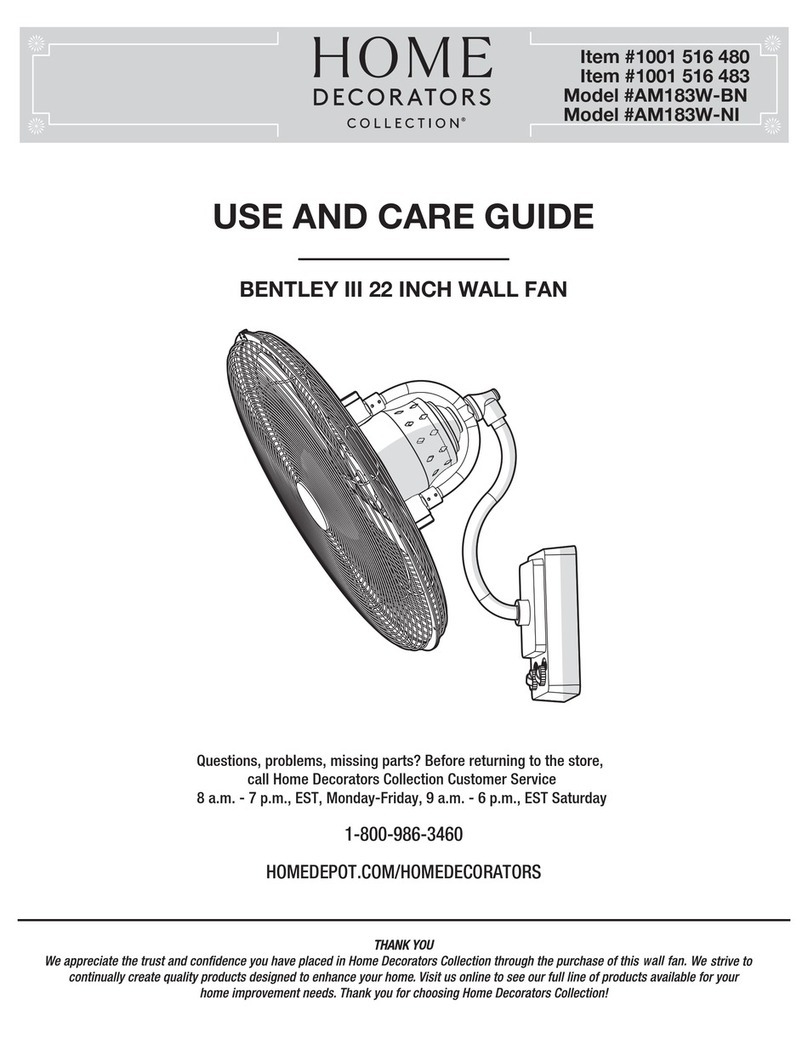
Home Decorators Collection
Home Decorators Collection AM183W-NI Use and care guide
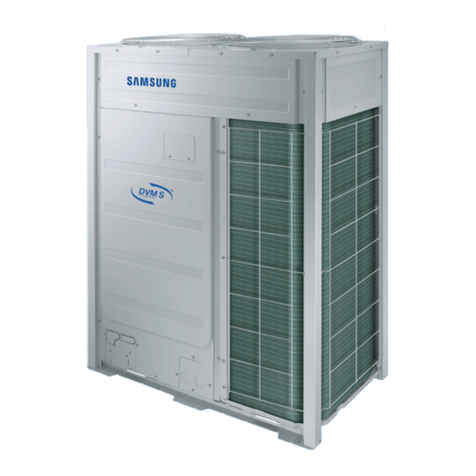
Samsung
Samsung VRF DVM S Water Technical data book
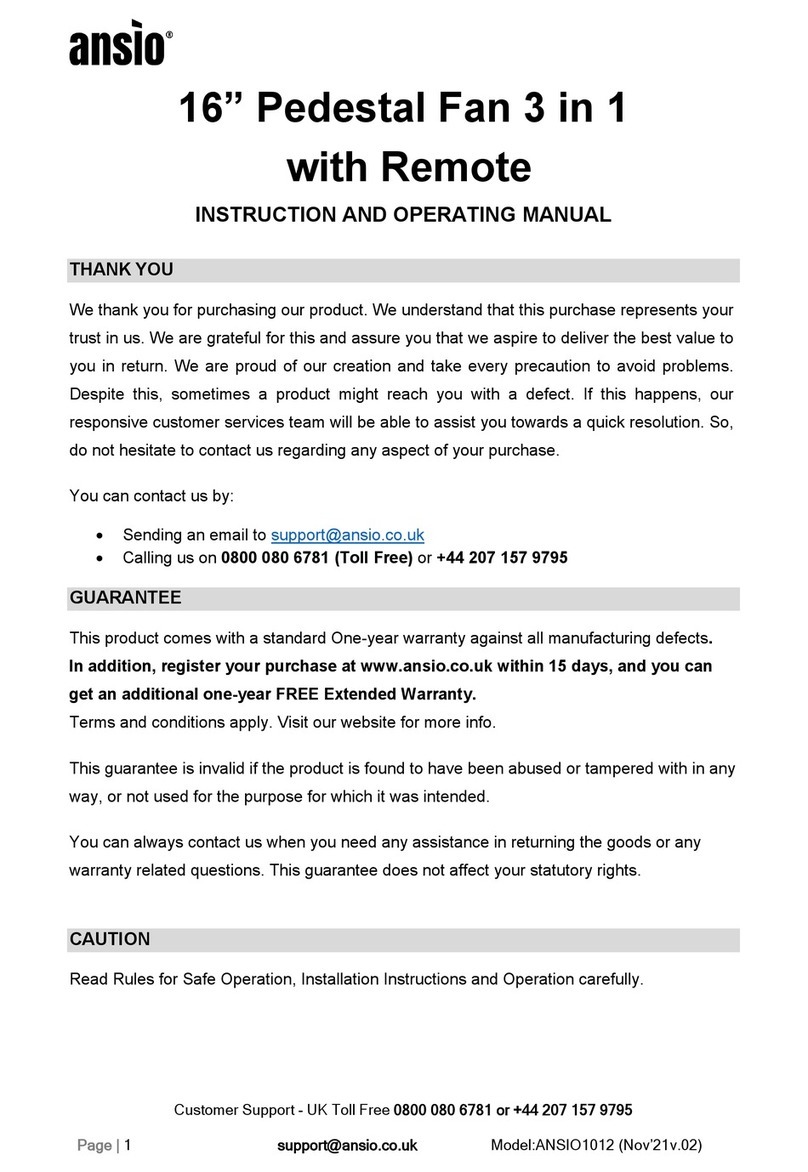
ansio
ansio ANSIO1012 Instructions and operating manual
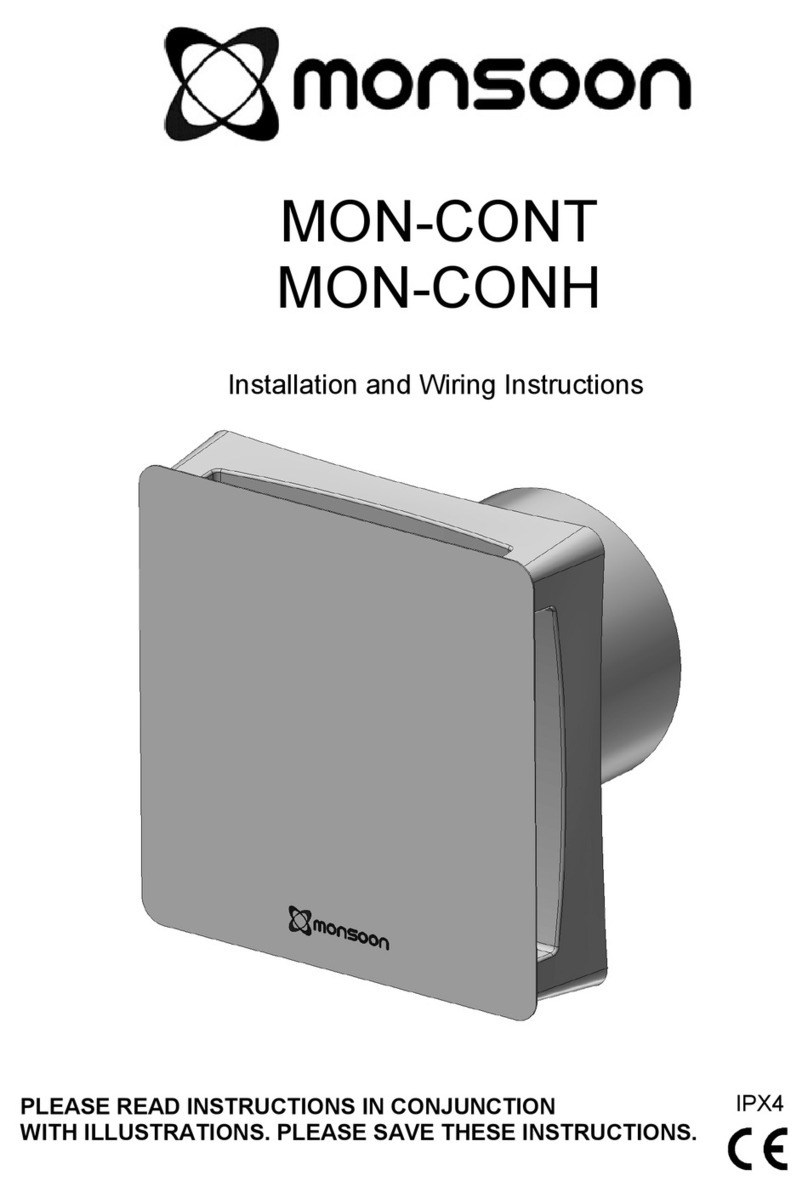
Monsoon
Monsoon MON-CONT Installation and wiring instructions
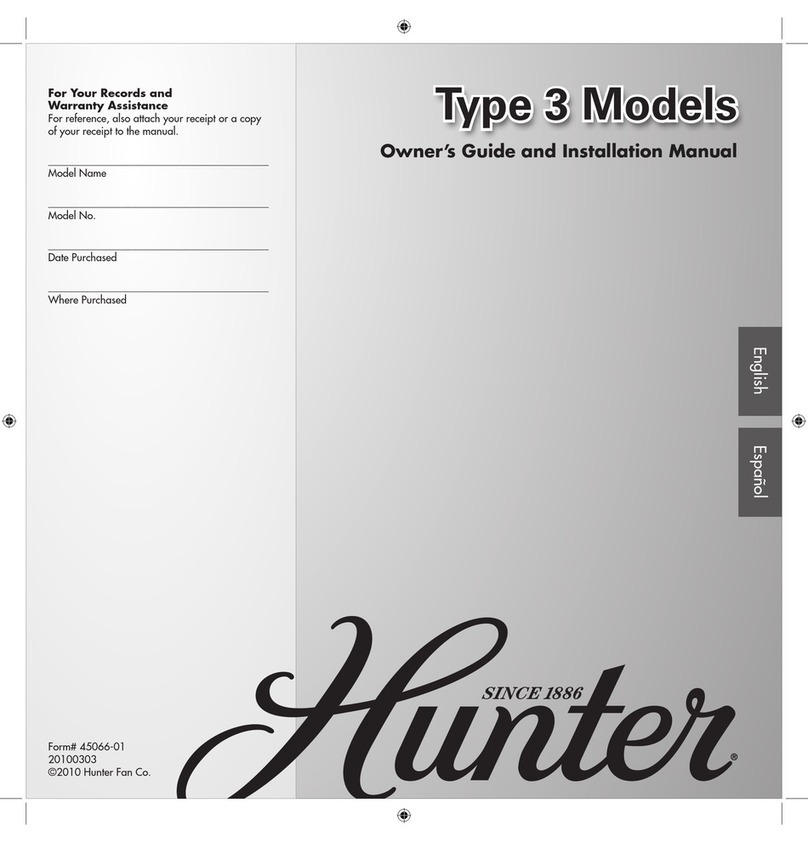
Hunter
Hunter Type 3 Models Owners and installation manual
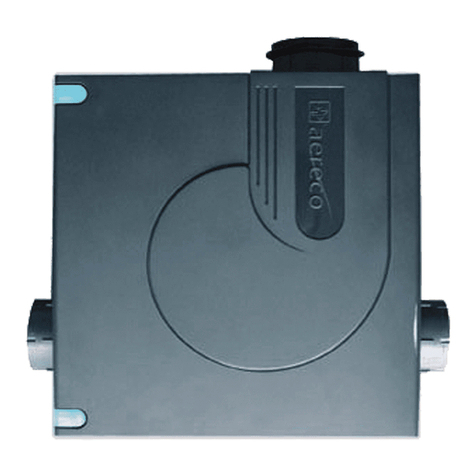
Aereco
Aereco V2A installation instructions
